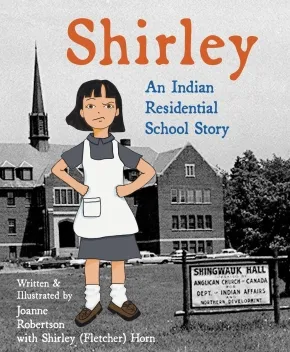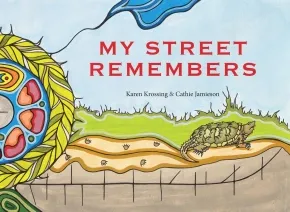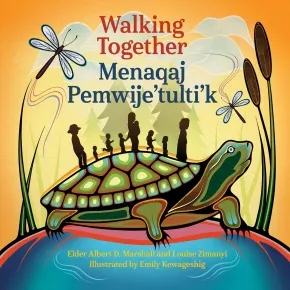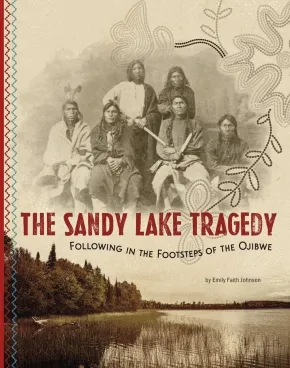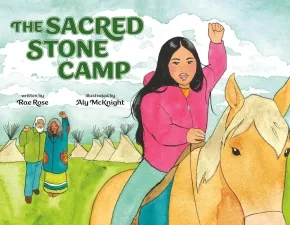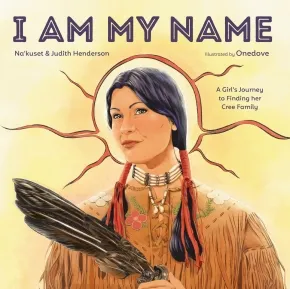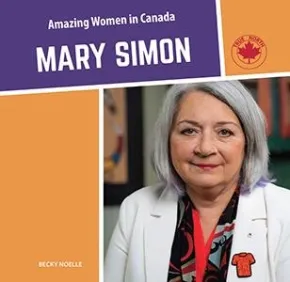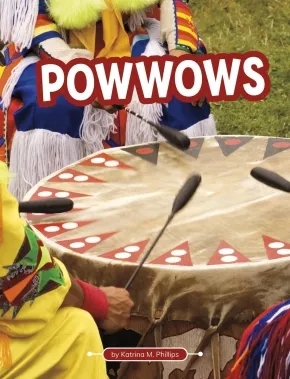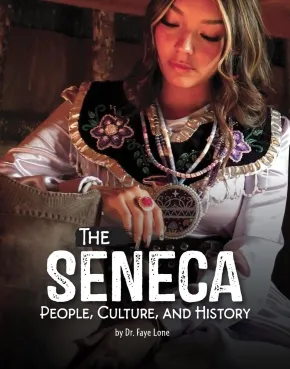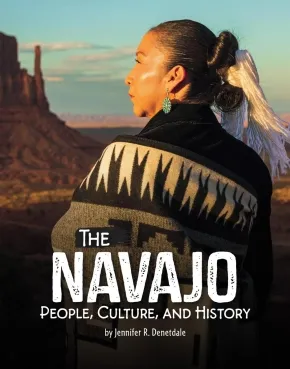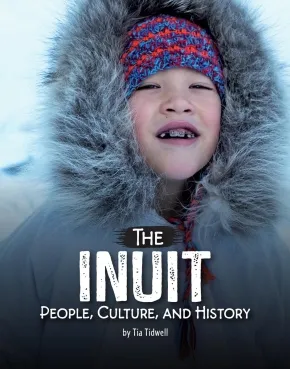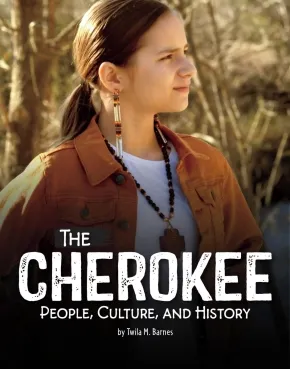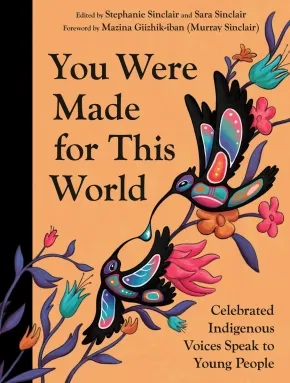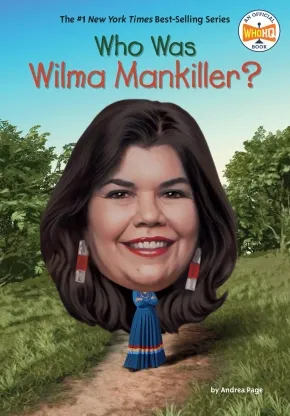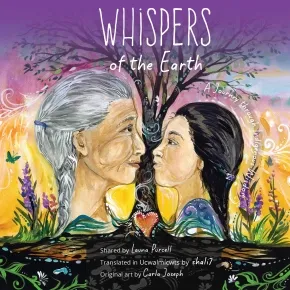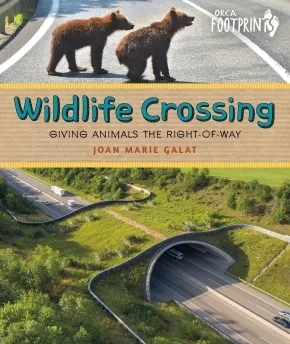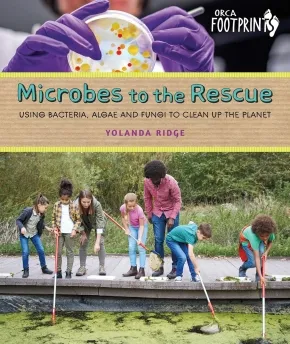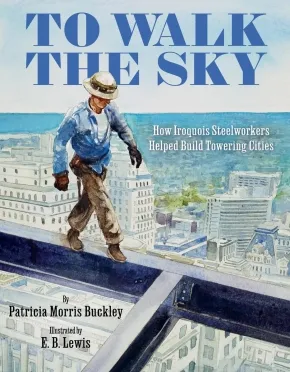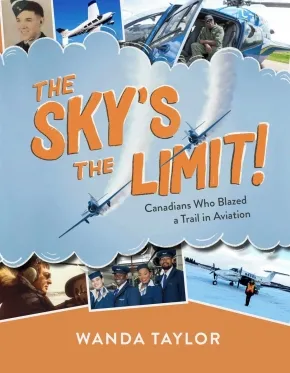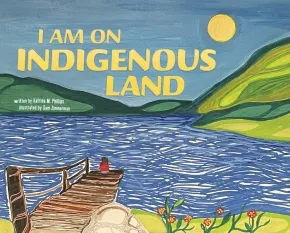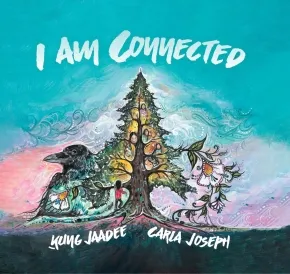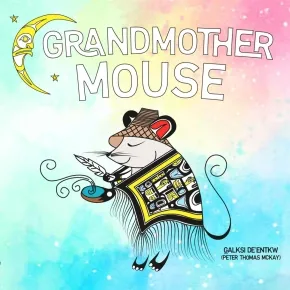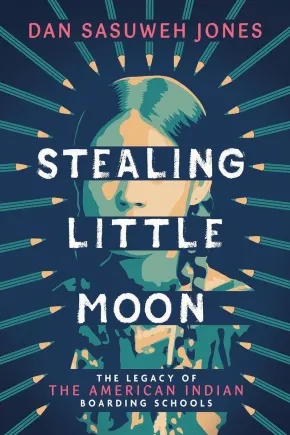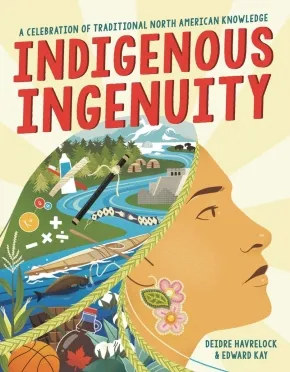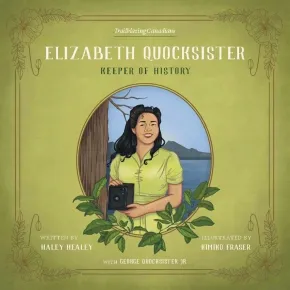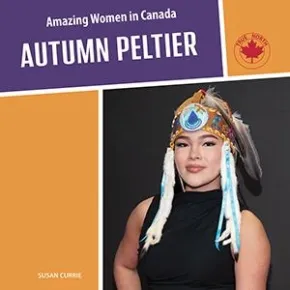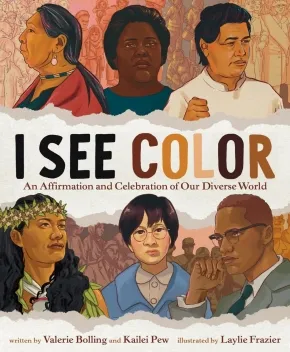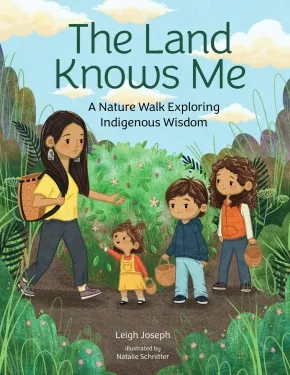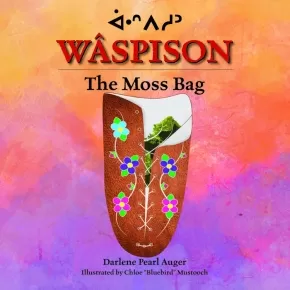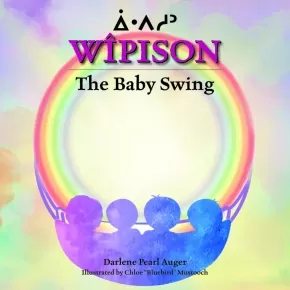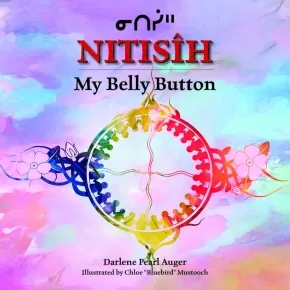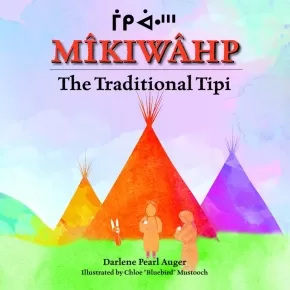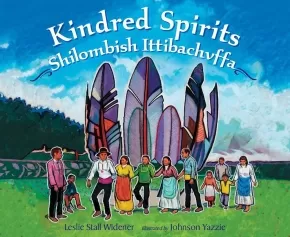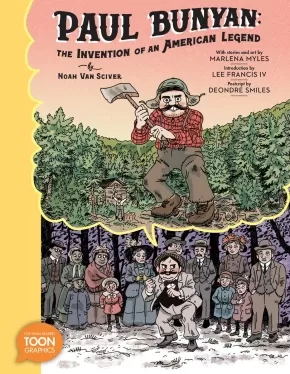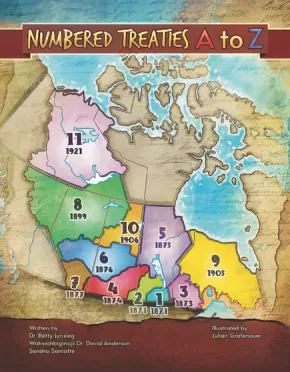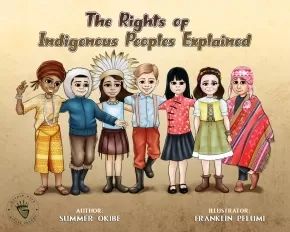
Information Circles
1
-
15
of
192 Results;
Sort By
Go To
of 13
Shirley: An Indian Residential School Story
$22.95
Format:
Paperback
Text Content Territories:
Indigenous Canadian; First Nations; Cree (Nehiyawak); Moose Cree; Missanabie Cree First Nation;
ISBN / Barcode: 9781772604542
Synopsis:
Synopsis:
Shirley is only five years old when she is taken away by the Indian agent to live at a residential school. She loves learning, but she is not there by choice. From the first day walking up the long, lonely stone steps of the school building, life is hard and full of rules. Separated from her brothers and sisters, she is truly on her own.
Shirley is very brave, but there is no one she loves to hold her at night when she is afraid. No one to tuck her in and comfort her. Shirley keeps going despite the sadness. She makes friends and has adventures. And most of all, she looks ahead to summertime, when she will be able to return to her family and the happiness of home.
A true story.
Reviews
"Through powerful words and illustrations, this book honors Shirley’s lived experiences at residential school while also highlighting her advocacy in ensuring that residential school histories are remembered and taught. Shirley offers an accessible entry point into a complex topic while centering Survivor voices. This book is a moving resource for educators and families committed to truth-telling and learning."- Krista McCracken, Researcher & Curator, Shingwauk Residential Schools Centre
Educator Information
Recommended for ages 9 to 12.
This book is available in French: Shirley: une histoire de pensionnat indien.
Additional Information
70 Pages | 7" x 8.5|" | Paperback
My Street Remembers
$21.99
Format:
Hardcover
Text Content Territories:
Indigenous Canadian;
ISBN / Barcode: 9781773066356
Synopsis:
Synopsis:
How many footsteps have walked your street in the past? My Street Remembers peels back the history of one city street in North America to reveal the greater story of the land on which we live.
The story begins 14,000 years ago, when mammoths roamed the icefields, and the First Peoples followed their trail. Historically accurate illustrations show the lives of their descendants over thousands of years as they hunted and gathered food, built homes and celebrated together, until the 1600s, when Europeans arrived with settlers in their wake.
In lyrical text, the street remembers agreements to live in peace, the efforts of the British to take the land with unfair treaties, and the conflict and suffering that followed. The street recalls its naming, paving and the waves of immigrants who called it home. Illustrations of recent times depict Canada's apology to Indigenous Peoples and efforts toward Truth and Reconciliation, including a march with a banner that reads: Every Child Matters.
This rich collaboration between author Karen Krossing, of White settler descent, and Anishinaabe artist Cathie Jamieson ends with a question that readers anywhere can ask-what does your street remember?
Reviews
"A thoughtful overview and reflection on the life and legacy of a busy street." — Booklist
Educator Information
Recommended for ages 3 to 6.
This book is part of the Better Path series.
Reading Levels: Lexile NC940L
Key Text Features:
- author's note
- bibliography
- captions
- explanation
- facts
- flags
- further information
- historical context
- historical note
- illustrations
- illustrator's notes
- sources
- timeline
- vignettes
- writing inspiration
Correlates to the Common Core State Standards in English Language Arts:
CCSS.ELA-LITERACY.RL.1.3
Describe characters, settings, and major events in a story, using key details.
Additional Information
48 pages | 11.00" x 8.00" | Hardcover
Walking Together / Menaqaj Pemwije’tulti’k
$24.99
Format:
Hardcover
Text Content Territories:
Indigenous Canadian; First Nations; Mi'kmaq (Mi'gmaq);
ISBN / Barcode: 9781834020174
Synopsis:
Synopsis:
This bestselling and award-winning introduction to Etuaptmumk—the gift of multiple perspectives also known as Two-Eyed Seeing—is now available in a bilingual edition that celebrates the Mi’kmaw language and our connections to nature.
Elder Albert D. Marshall is a leading environmental voice who has brought forward the concept of Etuaptmumk, honoring and braiding both Indigenous and non-Indigenous knowledges and ways of knowing for the benefit of all. Walking Together is grounded in this, as well as in the concept of Netukulimk, meaning to protect Mother Earth for the ancestors and for present and future generations. The journey in Walking Together nurtures respectful, reciprocal, responsible relationships with the Land and Water, with plant life and animals, and with other-than-human beings.
Translated by Barbara Sylliboy and Arlene Stevens, Eskasoni First Nation, Unama’ki (Cape Breton), Nova Scotia, the dual-language text in Mi’kmaw and English furthers Elder Marshall’s lifelong work preserving cultural beliefs and creating a strong vision for his people and for the future. Elder Marshall and Louise Zimanyi are working together to promote Land-based learning through storytelling, an approach that has global relevance for protecting biodiversity, climate action, and resilience. Emily Kewageshig’s evocative artwork illustrates the beauty of connecting with nature and encourages readers to strengthen their relationships to the world around them.
Educator Information
Recommended for ages 4 to 7.
Introduces the concept of Two-Eyed Seeing (the gift of multiple perspectives) to young readers.
Bilingual Edition: Mi’kmaw and English.
This book is available in English: Walking Together
Additional Information
40 pages | 9.00" x 9.00" | Hardcover
The Sandy Lake Tragedy: Following in the Footsteps of the Ojibwe
$13.99
Format:
Paperback
Text Content Territories:
Indigenous American; Native American; Anishinaabeg; Ojibwe (Chippewa);
ISBN / Barcode: 9798875206146
Synopsis:
Synopsis:
In 1850, 5,000 Ojibwe people were forced to make a dangerous journey across the Midwest to get treaty payments owed to them from the U. S. Government. But the payments never came, and the Ojibwe had to travel back home through treacherous winter conditions and without the money or supplies they had been promised. More than 400 Ojibwe lost their lives in this event that is now known as the Ojibwe Trail of Tears. Compelling narrative and impactful images help to recount the injustices of this forced removal and explain how it happened, what the many consequences were, how the Ojibwe people responded, and why this tragedy is still vitally relevant today. Author Emily Faith Johnson (Sault St. Marie Chippewa member) shares this not-to-be-forgotten story with young readers and educators seeking a closer look at U.S. history.
Educator Information
Recommended for ages 8 to 12.
Additional Information
32 pages | 8.00" x 10.00" | Paperback
The Sacred Stone Camp
$24.99
Artists:
Format:
Hardcover
Text Content Territories:
Indigenous American; Native American; Sioux; Dakota; Lakota;
ISBN / Barcode: 9780593696637
Synopsis:
Synopsis:
A stunning account of the Sacred Stone Camp's first day, where Indigenous activist LaDonna BraveBull Allard gathered water protectors to protest the Dakota Access Pipeline
The land is sacred to the people. The people are sacred to the land.
As Water Protectors gather to defend the water and protect the land against a black snake that threatens the rivers that millions of people depend on, a young girl looks to her Unci LaDonna and Lala Miles who are leading the way to the camp.
Although she’s nervous about what might happen next, she finds strength from her family and the strangers all coming together to stand up for what’s right.
Written with love by Rae Rose, who shares many memories with LaDonna, this is a deeply moving tribute to LaDonna’s work and impact with stunning watercolor illustrations by Aly McKnight.
Educator Information
Recommended for ages 5 to 9.
Additional Information
40 pages | 11.00" x 8.50" | Hardcover
I Am My Name: A Girl's Journey to Finding Her Cree Family
$26.99
Artists:
Text Content Territories:
Indigenous Canadian; First Nations; Cree (Nehiyawak);
ISBN / Barcode: 9780593648766
Synopsis:
Synopsis:
An evocative autobiographical picture book about Cree activist Na'kuset's life as a young girl taken from her home along with thousands of other indigenous children during the 1960s, and the journey of discovery that leads her to reclaim her life and culture.
I have come from somewhere else, where
I am Cree and I have a big sister
and another name.
One night, a very young girl was removed from her home during Canada’s Sixties Scoop, which tore children from their Indigenous communities. She woke in a new home, with a new family and a new name—her former life fading to a ghost of a memory. The only place she ever felt like she fit in was with her grandmother—her Bubbie—who listened to her and made her chicken soup and wrapped her in her loving arms. Until one day…the girl discovered the truth. And her beloved Bubbie helped her on her journey to claim her identity, her voice—and her name.
Together, Na'kuset and Judith Henderson tell the powerful story of the Indigenous experience for a child during the Sixities Scoop. Cree illustrator Onedove shared how inspired they are by Na'kuset's story and activism, and that is made evident in the tender and vivid illustrations that bring Na'kuset's story to life.
Educator Information
Recommendations for ages 6 to 9.
Lexile measure: 450L
Fountas & Pinnell Text Level Gradient: O
Additional Information
40 pages | 9.50" x 9.50" | Hardcover
Mary Simon
$14.95
Format:
Paperback
Text Content Territories:
Indigenous Canadian; Inuit;
ISBN / Barcode: 9781774562574
Synopsis:
Synopsis:
Discusses the life and accomplishments of Mary Simon, the first Indigenous person to hold office. She has served as the 30th governor general of Canada since July 26, 2021.
Educator Information
Juvenile Nonfiction.
Indigenous consultant: Dennis McPherson
Additional Information
24 Pages
A Kids Book About Racism
$26.99
Format:
Hardcover
ISBN / Barcode: 9780744085679
Synopsis:
Synopsis:
A clear explanation of what racism is and how to recognize it when you see it.
As tough as it is to imagine, this book really does explore racism. But it does so in a way that’s accessible to kids. Inside, you’ll find a clear description of what racism is, how it makes people feel when they experience it, and how to spot it when it happens.
Covering themes of racism, sadness, bravery, and hate. This book is designed to help get the conversation going. Racism is one conversation that’s never too early to start, and this book was written to be an introduction on the topic for kids aged 5-9.
A Kids Book About Racism features:
- A friendly, approachable, and kid-appropriate tone throughout.
- Expressive font design; allowing kids to have the space to reflect and the freedom to imagine themselves in the words on the pages.
- An author who has lived experience on the topic of racism.
Tackling important discourse together!
Educator Information
Recommended for ages 5 to 9.
Additional Information
64 pages | 8.00" x 10.38" | Hardcover
Powwows
$11.99
Format:
Paperback
Text Content Territories:
Indigenous American; Native American;
ISBN / Barcode: 9798875220005
Synopsis:
Synopsis:
Powwows are about dancing! Indigenous people in America come together at powwows to celebrate their culture and traditions with drumming, singing, and dancing. Together they remember their history and honor their ancestors. Dancers show off their best moves and fancy regalia in dances that tell stories or remember important moments in history. Lively photos and easy-to-read text help readers learn about contemporary powwow dances and traditions and their roots in the past. Readers will discover how Indigenous traditions honor the past and celebrate the present.
Educator Information
Recommended for ages 5 to 8.
Additional Information
32 pages | 7.00" x 9.00" | Paperback
The Seneca: People, Culture, and History
$11.99
Format:
Paperback
Text Content Territories:
Indigenous American; Native American; Haudenosaunee (Iroquois); Seneca;
ISBN / Barcode: 9798875208614
Synopsis:
Synopsis:
Strong kinship, rich stories, and lasting traditions—that’s the Seneca Nation. In this engaging nonfiction book for young readers, discover more about the people, places, and practices that connect Seneca communities across the Haudenosaunee Confederacy. Learn how the Seneca people thrive today by safeguarding their language, maintaining customs, and honoring their heritage through ceremonies and council gatherings. Through interactive activities and engaging features—including maps, timelines, recipes, and stories—Seneca author Dr. Faye Lone offers young readers a window into the past, present, and future of this enduring culture.
Educator & Series Information
Recommended for ages 8 to 11.
This book is part of the Indigenous Peoples series.
Additional Information
32 pages | 7.00" x 9.00" | Paperback
The Lakota: People, Culture, and History
$11.99
Format:
Paperback
Text Content Territories:
Indigenous American; Native American; Sioux; Lakota;
ISBN / Barcode: 9798875208379
Synopsis:
Synopsis:
Time-honored values, majestic landscapes, and a resilient spirit—that's the Lakota Nation. In this insightful nonfiction book for young readers, discover more about the people, places, and heritage of Lakota communities across the Northern Plains. Explore how the Lakota people continue to thrive by preserving their language, practicing timeless traditions, and celebrating respected ceremonies, like the annual Sun Dance, which brings relatives together in community and prayer. Through interactive activities and engaging features—including maps, timelines, recipes, and crafts—Lakota author Tracy Hauff introduces young learners to the past, present, and future of this vibrant culture.
Educator & Series Information
Recommended for ages 8 to 11.
This book is part of the Indigenous Peoples series.
Additional Information
32 pages | 7.00" x 9.00" | Paperback
The Navajo: People, Culture, and History
$11.99
Format:
Paperback
Text Content Territories:
Indigenous American; Native American; Navajo (Diné);
ISBN / Barcode: 9798875208454
Synopsis:
Synopsis:
Spiritual ceremonies, powerful storytelling, and timeless wisdom—that’s the Navajo Nation. In this captivating nonfiction book for young readers, discover more about the people, places, and traditions that unify the Navajo Nation. Learn how the Navajo people continue to thrive in the Southwest by preserving their language, celebrating cultural practices, and participating in meaningful ceremonies, such as the Kinaaldá, a coming-of-age ritual for young women. Through interactive activities and engaging features—including maps, timelines, recipes, and crafts—Navajo author Jennifer R. Denetdale shares valuable insights into the past, present, and future of this resilient culture.
Educator & Series Information
Recommended for ages 8 to 11.
This book is part of the Indigenous Peoples series.
Additional Information
32 pages | 7.00" x 9.00" | Paperback
The Ojibwe: People, Culture, and History
$11.99
Format:
Paperback
Text Content Territories:
Indigenous American; Native American; Anishinaabeg; Ojibwe (Chippewa);
ISBN / Barcode: 9798875208539
Synopsis:
Synopsis:
Spirited powwows, close family ties, and a deep connection to the land—that’s the Ojibwe Nation. In this captivating nonfiction book for young readers, discover more about the people, places, and customs that shape Ojibwe life across the Great Lakes region. Uncover how the Ojibwe people continue to thrive by preserving their language, celebrating traditions, and gathering at powwows, where drumming, dancing, and storytelling keep their culture alive. Through interactive activities and engaging features—including maps, timelines, recipes, and crafts—Ojibwe author Kim Sigafus provides young learners with meaningful insights into the past, present, and future of this enduring culture.
Educator & Series Information
Recommended for ages 8 to 11.
This book is part of the Indigenous Peoples series.
Additional Information
32 pages | 7.00" x 9.00" | Paperback
The Inuit: People, Culture, and History
$11.99
Format:
Paperback
Text Content Territories:
Indigenous American; Alaska Native; Inupiat (Alaskan Inuit);
ISBN / Barcode: 9798875208294
Synopsis:
Synopsis:
Colorful celebrations, ancient histories, and enduring customs—that’s the Inuit people. In this insightful nonfiction book for young readers, discover more about the people, places, and customs that connect Inuit communities across the vast Arctic landscape. Explore how the Inuit people thrive in Earth’s northernmost regions by honoring their language, preserving traditional ways of life, and gathering for celebrations, such as Kivgiq, a joyful festival of music, drumming, and dance. Through interactive activities and engaging features—including maps, timelines, recipes, and stories—Iñupiaq author Tia Tidwell offers young learners valuable insights into the past, present, and future of this remarkable culture.
Educator & Series Information
Recommended for ages 8 to 11.
This book is part of the Indigenous Peoples series.
Additional Information
32 pages | 7.00" x 9.00" | Paperback
The Cherokee: People, Culture, and History
$11.99
Format:
Paperback
Text Content Territories:
Indigenous American; Native American; Cherokee;
ISBN / Barcode: 9798875208218
Synopsis:
Synopsis:
Vibrant traditions, rich histories, and strong voices—that’s the Cherokee Nation. In this inspiring nonfiction book for young readers, discover more about the people, places, and culture of one of the United States’ largest Indigenous groups. Explore how the Cherokee people still survive—and thrive—by safeguarding their language, reviving customs, and upholding celebrations, like the annual Cherokee National Holiday that honors their heritage. Through interactive activities and engaging features—including maps, timelines, recipes, and crafts—Cherokee author Twila M. Barnes provides young learners with important insights into the past, present, and future of the Cherokee people.
Educator & Series Information
Recommended for ages 8 to 11.
This book is part of the Indigenous Peoples series.
Additional Information
32 pages | 7.00" x 9.00" | Paperback
FLASH SALE! You Were Made for This World: Celebrated Indigenous Voices Speak to Young People
$21.75 $28.99
Artists:
Format:
Hardcover
Text Content Territories:
Indigenous Canadian; Métis; Inuit; First Nations;
ISBN / Barcode: 9781774882566
Synopsis:
Synopsis:
A joyful, proud and groundbreaking collection of letters and art for young people, You Were Made for This World brings together celebrated Indigenous voices from across Turtle Island.
Every young person deserves the chance to feel like they belong, that they are recognized, that they matter. In the spirit of A Velocity of Being: Letters to a Young Reader, You Were Made for This World brings together forty Indigenous writers, artists, activists, athletes, scholars and thinkers with a joint purpose: to celebrate the potential of young people, to share a sense of joy and pride in language, traditional and personal stories and teachings, and shared experiences, and to honor young people for who they are and what they dream of.
Including contributions from activist Autumn Peltier, singer/songwriter Tanya Tagaq, hockey player Ethan Bear, Governor General's Award–winning author David A. Robertson, artists Chief Lady Bird and Christi Belcourt, illustrator Mangeshig Pawis-Steckley, and dozens of others, this beautifully collaborative collection urges readers to think about who they are, where they come from and where they're going, with a warm familiarity that will inspire you to see yourself and your community with proud eyes.
Also includes a ribbon bookmark.
Educator Information
Recommended for ages 8 to 12.
Additional Information
120 pages | 7.50" x 10.00" | Hardcover
Who Was Wilma Mankiller?
$9.50
Format:
Paperback
Text Content Territories:
Indigenous American; Native American; Cherokee; Cherokee Nation (Cherokee Nation of Oklahoma);
ISBN / Barcode: 9780593888872
Synopsis:
Synopsis:
Learn about the life and legacy of the first woman to serve as principal chief of the Cherokee Nation! Wilma Mankiller's struggle for political change throughout her life will be sure to inspire readers in this addition to the #1 New York Times bestselling series.
Wilma Mankiller grew up immersed in the Cherokee community and culture of Oklahoma. When her family moved to San Francisco as part of the Indian Relocation Program, she had to quickly adjust to city life. Along the way, Wilma never lost her dedication to her people and their centuries-old traditions. She grew up to become a major political activist. From aiding the Occupation of Alcatraz in 1969 to making history as the first woman principal chief of the Cherokee Nation in 1985, Wilma never wavered in her support for her community. She spent her life fighting for the rights of Native Americans and inspires political activism to this day.
Educator Information
Recommended for ages 8 to 12.
Additional Information
112 pages | 5.31" x 7.62" | Paperback
Whispers of the Earth: A Journey through Indigenous Wisdom
$29.00
Artists:
Format:
Paperback
Text Content Territories:
Indigenous Canadian; First Nations; Salish; Interior Salish; St'at'imc (Lillooet, Lil'Wat);
ISBN / Barcode: 978-1-73869-534-8
Synopsis:
Synopsis:
Prepare to embark on a journey rich with the wisdom of our ancestors and the secrets shared by Mother Earth.
In this children’s book, you will follow a path once tread by those before us, where the songs of the trees, the dance of the rivers, and our stories are carried by the wind. These teachings are invaluable treasures passed down through generations.
You’ll discover the language of animals, the lessons of plants, and the wisdom of the land. If you listen closely, you will hear the “Whispers of the Earth,” guiding you on this incredible adventure.
Educator Information
Recommended for kindergarten to grade 7.
Carl Sam advised on the language, and is “Ha7li” of the Bear Clan from Skookumchuck, part of St’at’icmulh Nation, sometimes referred to as the Interior Salish. Through this book, he shares elements of the Ucwalmícwts language.
Includes some words in Ucwalmícwts.
Additional Information
60 pages | 20 × 20 × 1 cm | Paperback | Printed locally on 100% post-consumer recycled paper.
Wildlife Crossing: Giving Animals the Right-of-Way
$21.95
Format:
Hardcover
ISBN / Barcode: 9781459833463
Synopsis:
Synopsis:
What happens when the needs of people and nature collide?
More than 13 million miles of roads crisscross landscapes in 222 countries. Roads offer many human benefits, but they also create problems for nature. Their construction leads to a loss of biodiversity through habitat loss, fragmentation and degradation. Roads isolate wildlife populations, impede migration and allow invasive plant and animal species to spread, while giving rise to pollution from garbage, light, noise and airborne contaminants. With innovative tools, like wildlife overpasses to reconnect landscapes, smart roads and vehicles to maximize safety, and a little hands on help, we can create environmental harmony. And sitting in the passenger seat, young people can play a part in helping highways and habitats coexist.
Reviews
“Well organized and includes clearly explained examples from many locations…This volume offers considerably more information for students researching the topic. An intriguing subject and a good resource for middle-grade reports.”— Booklist
“Gorgeous, crisp photographs complement the well-written text…A first purchase for libraries that need more books on the topic of conservation and the impact of development on wildlife.” — School Library Journal (SLJ)
“A fascinating, invaluable and enlightening tool for libraries, schools and homes alike. Wildlife Crossing will empower all readers to do their part when it comes to road ecology and will undoubtedly spark meaningful conversations about what it means to coexist with nature. Very highly recommended.”— Canadian Children's Book Centre (CCBC) Canadian Children’s Book News
“Wildlife Crossing gives an intriguing overview of the topic in just 48 pages, but it is a good addition to science collections with a focus on the environment. Highly Recommended.”— CM: Canadian Review of Materials
Educator & Series Information
Recommended for ages 9 to 12.
This book is part of the Orca Footprint series.
Reading Levels:
Fountas & Pinnell Text Level Gradient: X
Lexile measure: 1130L
Guided Reading Level: X
Additional Information
48 pages | 8.00" x 9.50" | Includes 74 colour photographs, 1 index, 1 bibliography | Hardcover
Our Plastic Problem: A Call for Global Solutions
$21.95
Format:
Hardcover
ISBN / Barcode: 9781459836709
Synopsis:
Synopsis:
We have a serious plastic problem.
What was supposed to be a miracle material when it was first invented is now one of the biggest sources of pollution on our planet. But where does plastic come from? Why do we use so much of it? How does it hurt the environment and the animals who live there? Our Plastic Problem looks at plastic's history, uses, and how it affects land, water, air and human health. It also explores innovations in bioplastic and recycling, and practical ways to reduce and replace the plastic in our lives. Working together, we can solve our plastic problem.
Reviews
“Like other books in the Orca Footprints series, this volume is accessible, broadly informative, and illustrated with many pertinent color photos. A timely introduction to a serious environmental issue.” — Booklist
“Durnford effectively communicates a sense of urgency. Young eco-activists will also find general guidelines for localized projects, as well as specific instructions for laundering clothing to reduce microfibre shedding, among other immediately applicable advice. Accentuates the positive without minimizing the issue’s scope.” — Kirkus Reviews
“This is a great introduction to the history of plastics. Very informative and written at a level that is digestible for young readers. Would work well with a study unit. Hand this book to budding environmentalists or anyone interested in learning more about the plastic problem. A recommended purchase for updating nonfiction collections.” — School Library Journal (SLJ)
Educator & Series Information
Recommended for ages 9 to 12.
This book is part of the Orca Footprint series.
Reading Levels:
Fountas & Pinnell Text Level Gradient: X
Lexile measure: 1070L
Guided Reading Level: X
Additional Information
48 pages | 8.00" x 9.50" | Includes 78 colour photographs, 1 index, 1 bibliography | Hardcover
Microbes to the Rescue: Using Bacteria, Algae and Fungi to Clean Up the Planet
$21.95
Format:
Hardcover
ISBN / Barcode: 9781459839137
Synopsis:
Synopsis:
Microbes are tiny but mighty, and they're everywhere!
When left alone, microbes such as bacteria, fungi and algae are experts at adapting, surviving and thriving under extreme and constantly changing conditions. These natural problem solvers can help fight the climate crisis by gobbling up pollutants, breaking down plastic, generating clean energy and capturing carbon. By harnessing the power of microbes, we can create eco-friendly packaging, farm-free food, and even make it easier to live in space! Microbes to the Rescue will introduce young readers to life on a microscopic level and explore how bacteria, fungi and algae play a key role in the connection between all life on Earth. Let’s get microscopic and learn about how microbes can create a cleaner and more sustainable future.
Educator & Series Information
Recommended for ages 9 to 12.
This book is part of the Orca Footprint series.
Reading Levels:
Fountas & Pinnell Text Level Gradient: X
Lexile measure: 1110L
Guided Reading Level: X
Additional Information
56 pages | 8.00" x 9.50"| Includes 63 colour photographs, 1 index, 1 bibliography | Hardcover
To Walk the Sky: How Iroquois Steelworkers Helped Build Towering Cities
$24.99
Artists:
Format:
Hardcover
ISBN / Barcode: 9780063046979
Synopsis:
Synopsis:
Look to the sky!
High above the ground, generation after generation, Native workers called skywalkers have sculpted city skylines, balancing on narrow beams, facing down terrifying heights and heartbreaking loss. These skywalkers who dared to touch the heavens have built a legacy of landmarks all over the North American continent—and even today, there are Native Americans still climbing up among the clouds, brave enough to walk the sky.
With impactful and illuminating prose, Patricia Morris Buckley (Mohawk) tells the soaring story of the remarkable skywalkers, whose bravery and tragedies are warmly captured in moving watercolors by award-winning artist E. B. Lewis (Lenni-Lenape).
Reviews
"By turns solemnly reverent and enthusiastic, Buckley’s elegant text will leave young people keenly aware of the historical and present-day significance of these groundbreaking workers, as well as their strength and resilience. Awe-inspiring." — Kirkus Reviews (starred review)
"Graceful language honors skywalkers throughout this stirring telling, while fluidly rendered watercolor illustrations in a desaturated color palette employ sweeping perspective and scale." — Publishers Weekly (starred review)
"This fascinating narrative provides an in-depth history of skywalkers, the Caughnawaga, and their contributions to our cities and infrastructure." — School Library Journal (starred review)
"The text, even with all its facts and figures, is deeply emotional, capturing the giddy danger of skywalking, the relentless need to better one’s life, and the sorrow in a preventable tragedy...blurring faces and bodies in a way that emphasizes the comradery and connection between the workers." — Bulletin of the Center for Children’s Books
"Here, a descendant of one of the 75 workers who died in the 1907 collapse of the Quebec Bridge pays eloquent tribute to the first generation of Mohawk “skywalkers” who came out of the Caughnawaga (later Kahnawà:ke) reserve in Canada." — Booklist
Educator Information
Recommended for ages 4 to 8.
Additional Information
40 pages | 8.50" x 11.00" | Hardcover
The Sky's The Limit!: Canadians Who Blazed a Trail in Aviation
$19.95
Format:
Paperback
Text Content Territories:
Indigenous Canadian; First Nations; Cree (Nehiyawak); Swampy Cree ; Opaskwayak; Dene; Dinjii Zhuh (Gwich'in);
ISBN / Barcode: 9781774712672
Synopsis:
Synopsis:
This action-packed, full-colour middle-grade non-fiction book opens up the world of aviation to youth from diverse backgrounds, through the incredible stories of Canadians who broke barriers to reach the sky—from Newfoundland and Labrador to Manitoba to the Yukon.
From commercial, transport, and military pilots to search-and-rescue helicopter pilots to airplane mechanics, The Sky's the Limit! introduces readers to inspiring contemporary aviators, including commercial pilot Captain Mohamed Samanter, Gwich'in pilot Fred Carmichael, and Kimberly Ballantyne, the first woman of the Opaskwayak Cree Nation to become a pilot. Along the way, readers will learn important context about the history of flight in Canada, including the Royal Canadian Air Force, the Black soldiers of the No. 2 Construction Battalion, military pilot Allan Selwyn Bundy—one of only two known Black Canadian combat pilots who flew during the Second World War—and many more.
Educator Information
Recommended for ages 7 to 10.
Featuring sidebars, profiles of various aircraft, photographs, illustrations, as well as a glossary and bibliography, The Sky’s the Limit! is a much needed STEAM resource for young readers interested in a career in aviation, and an inspiring story for the millions of kids who haven’t seen themselves represented in the skies.
Includes some Indigenous content.
Additional Information
88 Pages | 50+ Colour Images | Paperback
Baby Smiles/Weskewikwa'sit mijua'ji'j (BB)
$14.95
Artists:
Format:
Board Book
Text Content Territories:
Indigenous Canadian; First Nations; Mi'kmaq (Mi'gmaq);
Grade Levels: Preschool;
ISBN / Barcode: 9781774712214
Synopsis:
Synopsis:
A bilingual Mi'kmaw-English board book promoting dental health in baby's first year.
Every morning and every night I need help brushing my teeth.
Look at me smiling so healthy and happy.
Healthy gums and teeth improve overall wellness and quality of life, and help you feel confident in your smile. Beginning during pregnancy, there are things you can do to support your child's gum and teeth health.
This informative board book written in Mi'kmaw and English will teach caregivers how to support their child's oral health through their first year of life and beyond. Develop healthy habits and learn what food and drink is best for growing teeth and gums, when to take baby to their first dental visit, and the appropriate amount of toothpaste for children.
Written by the Tui'kn Partnership with support from the Dalhousie University Faculty of Dentistry, Baby Smiles will make sure that baby's teeth are healthy and happy their whole life long.
Educator Information
Recommended for ages 3 and under.
Dual-Language: Mi'kmaw-English.
Additional Information
28 pages | 7.00" x 7.00" | Board Book
I Am on Indigenous Land
$25.99
Format:
Hardcover
Text Content Territories:
Indigenous American; Native American; Shawnee; Seminole; Salish; Coast Salish; Nisqually; Navajo (Diné); Ho-Chunk (Winnebago); Haudenosaunee (Iroquois); Tuscarora; Chickasaw; Blackfoot Confederacy (Siksikaitsitapi); Anishinaabeg; Ojibwe (Chippewa); Indigenous Caribbean; Taino;
ISBN / Barcode: 9781684363087
Synopsis:
Synopsis:
With simple, lyrical text and vibrant panoramic illustrations, this picture book explores the beauty and resources of thirteen ancestral Indigenous lands and how we all use those lands each day. Simple poetry and portrayals of children and families enjoying rivers, bike paths, beaches, and parks show how everyday activities can include honoring Indigenous nations and cultures.
Author Katrina Phillips (Ojibwe citizen) and illustrator Sam Zimmerman (Ojibwe direct descendant) together have crafted a loving tribute that gently demonstrates recognition and acknowledgement of the nations of people who first called these lands home.
Educator Information
Recommended for ages 3 to 9.
Additional Information
32 pages | 10.00" x 8.00" | Hardcover
I am Connected
$22.99
Artists:
Format:
Hardcover
Text Content Territories:
Indigenous Canadian; First Nations; Haida;
ISBN / Barcode: 9781778540639
Synopsis:
Synopsis:
We are all connected. Whether it is with your family, the mossy earth beneath your feet, the warm guidance of your ancestors, you belong in connection with all around you.
Along the backdrop of Haida Gwaii's breathtaking landscapes, Indigenous storyteller, Ḵung Jaadee, invites you to witness the many threads of relationship that connect us across time and space.
What makes you feel connected?
Educator Information
Recommended for ages 6+.
Includes a few word and phrases in the Haida language.
A teacher lesson plan is available here: I am Connected Teacher Lesson Plan.
This book is available in French: Je suis liée.
Additional Information
28 pages | 9.00" x 10.00" | Hardcover
Grandmother Mouse
$19.99
Artists:
Format:
Hardcover
ISBN / Barcode: 9781778540608
Synopsis:
Synopsis:
When the nighttime sky fills with stars, Grandmother Mouse awakens and begins her grounding ceremonies.
Inhale, exhale
Inhale, exhale
Inhale, exhale. . .
Gifted to the Nisg̱a'a People, Grandmother Mouse is a nurturing protector, tending to the hearts and minds of the people, the plants, the animals, and all of our relations. Imbuing the world with smudge, blessings, and affirmations, Grandmother Mouse is here to offer you gentle, yet profound, teachings so you may walk through life with good intention and strong spirit.
Educator Information
Recommended for ages 4+.
Additional Information
24 pages | 8.00" x 8.00" | Hardcover
Stealing Little Moon: The Legacy of the American Indian Boarding Schools
$26.99
Format:
Hardcover
Text Content Territories:
Indigenous American; Native American; Ponca; Ponca Tribe of Indians of Oklahoma ;
ISBN / Barcode: 9781338889475
Synopsis:
Synopsis:
"Stealing Little Moon is both a moving family saga and an expertly told true story that all Americans should know." —Steve Sheinkin, New York Times bestselling author of Bomb and Undefeated
Little Moon There Are No Stars Tonight was four years old when armed federal agents showed up at her home and took her from her family. Under the authority of the government, she was sent away to a boarding school specifically created to strip her of her Ponca culture and teach her the ways of white society. Little Moon was one of thousands of Indigenous children forced to attend these schools across America and give up everything they'd ever known: family, friends, toys, clothing, food, customs, even their language. She would be the first of four generations of her family who would go to the Chilocco Indian Agricultural School.
Dan SaSuWeh Jones chronicles his family's time at Chilocco--starting with his grandmother Little Moon's arrival when the school first opened and ending with him working on the maintenance crew when the school shut down nearly one hundred years later. Together with the voices of students from other schools, both those who died and those who survived, Dan brings to light the lasting legacy of the boarding school era.
Part American history, part family history, Stealing Little Moon is a powerful look at the miseducation and the mistreatment of Indigenous kids, while celebrating their strength, resiliency, and courage--and the ultimate failure of the United States government to erase them.
Educator Information
Recommended for ages 9 to 12.
Additional Information
304 pages | 5.50" x 8.25" | Hardcover
Indigenous Ingenuity: A Celebration of Traditional North American Knowledge (PB)
$12.99
Artists:
Format:
Paperback
ISBN / Barcode: 9780316413435
Synopsis:
Synopsis:
Celebrate Indigenous thinkers and inventions with this beautifully designed, award-winning interactive nonfiction book—perfect for fans of Braiding Sweetgrass.
Corn. Chocolate. Fishing hooks. Boats that float. Insulated double-walled construction. Recorded history and folklore. Life-saving disinfectant. Forest fire management. Our lives would be unrecognizable without these, and countless other, scientific discoveries and technological inventions from Indigenous North Americans.
Spanning topics from transportation to civil engineering, hunting technologies, astronomy, brain surgery, architecture, and agriculture, Indigenous Ingenuity is a wide-ranging STEM offering that answers the call for Indigenous nonfiction by reappropriating hidden history. The book includes fun, simple activities and experiments that kids can do to better understand and enjoy the principles used by Indigenous inventors. Readers of all ages are invited to celebrate traditional North American Indigenous innovation, and to embrace the mindset of reciprocity, environmental responsibility, and the interconnectedness of all life.
Reviews
"An astonishing, exuberant treasure trove of history, science and hands-on activities that repeatedly begs the question: "Why didn't I know this?" Essential for kids and adults. We need this book." —Candace Fleming, award-winning author of The Rise and Fall of Charles Lindbergh and The Family Romanov
"This book will amaze readers and teachers as it demonstrates how pervasive and critical the history of Indigenous people is. A completely unique and important narrative not to be missed; readers and teachers will come away with a new appreciation for the myriad contributions Indigenous people have made."—SLJ, starred review
"A conversational tone invites readers to engage with this monumental collection . . . Curious readers will learn facts unique to individual tribal groups while gaining knowledge of STEM/STEAM concepts. An ambitious, appealing, and accessible work documenting and protecting valuable knowledge."—Kirkus Reviews
"Engaging and informative, this will be welcomed by both STEM and social studies curricula to help to correct prevailing narratives about Indigenous technology."—Booklist, starred review
"Via authoritative, meticulously researched prose, the creators detail Native peoples’ significant strides in scientific pursuits . . . [and] showcase Native tribes’ continual and enduring impact. Photographs, as well as interactive activities detailing recipes and science experiments, feature throughout, lending a hands-on approach to this clear and concise work."—Publishers Weekly
"This book is a valuable contribution to efforts to decolonize learning and introduce readers to the breadth of indigenous knowledge as practiced in widely disparate geographic zones."—Canadian Review of Materials
"An engaging and cleverly compiled guide to North American and Mesoamerican Indigenous innovation. STEM topics (housing, medicine, clothing, agriculture, and hunting among them) are compellingly and conversationally discussed."—Shelf Awareness
Educator Information
Recommended for ages 8 to 12.
Fountas & Pinnell Text Level Gradient: Z
Additional Information
288 pages | 6.95" x 9.00" | Paperback
Elizabeth Quocksister: Keeper of History (PB)
$12.95
Artists:
Format:
Paperback
Text Content Territories:
Indigenous Canadian; First Nations; Kwakwaka'wakw (Kwakiutl); Da'naxda'xw Awaetlala;
ISBN / Barcode: 9781772034851
Synopsis:
Synopsis:
The uplifting true story of Elizabeth Quocksister, a strong Indigenous woman and community leader, who dedicated her life to protecting her language and cultural traditions.
Elizabeth Quocksister (1925–81) had many roles in her life. She was a cultural teacher, a community leader, a dancer, a nurse, a photographer, a residential school survivor, and a mother of ten. Born on the Da’naxda’xw Nation on Knight Inlet on the central coast of British Columbia, Elizabeth spoke fluent Kwak’wala and proudly celebrated her Kwakwaka’wakw culture at a time when the Canadian government actively discouraged Indigenous traditions and the speaking of Indigenous languages. She cared for community members in need and saved many children from the horrors of residential school. She chronicled the daily lives, important events, and changing times of her community through photography—preserving her people’s history and culture for future generations. This inspiring picture book is a beautiful tribute to a proud Indigenous woman whose name deserves to be well-known throughout her community and beyond.
Educator Information
Recommended for ages 4 to 8.
Additional Information
32 pages | 9.00" x 9.00" | Paperback
Autumn Peltier
$14.95
Format:
Paperback
Text Content Territories:
Indigenous Canadian; First Nations; Anishinaabeg; Wiikwemkoong Unceded Territory;
ISBN / Barcode: 9781774566718
Synopsis:
Synopsis:
Only 19 years old, Autumn Peltier has achieved so much by advocating for her community. Discover more about her advocacy for Indigenous peoples and clean water.
Educator Information
Juvenile Nonfiction.
Additional Information
24 Pages
Walking Together (PB)
$12.99
Format:
Paperback
Text Content Territories:
Indigenous Canadian; First Nations; Mi'kmaq;
ISBN / Barcode: 9781773217772
Synopsis:
Synopsis:
This bestselling, innovative picture book introduces readers to the concept of Etuaptmumk—or Two-Eyed Seeing, the gift of multiple perspectives in the Mi’kmaw language—as we follow a group of young children connecting to nature as their teacher.
A poetic, joyful celebration of the Lands and Waters as spring unfolds: we watch for Robin's return, listen for Frog's croaking, and wonder at maple tree's gift of sap. Grounded in Etuaptmumk, also known as Two-Eyed Seeing—which braids together the strengths of Indigenous and non-Indigenous ways of knowing—and the Mi’kmaq concept of Netukulimk—meaning to protect Mother Earth for the ancestors, present, and future generations—Walking Together nurtures respectful, reciprocal, responsible relationships with the Land and Water, plant-life, animals and other-than-human beings for the benefit of all.
Reviews
"Walking Together is a poetic celebration grounded in Etuaptmumk (Two-Eyed Seeing) that weaves together the strengths of Indigenous and non-Indigenous ways of knowing. The story explores respectful, reciprocal, responsible relationships between the land, water, plants, animals, and humans." - The Dalai Lama Center
Educator Information
Recommended for ages 4 to 7.
Introduces the concept of Two-Eyed Seeing (the gift of multiple perspectives) to young readers.
This book is available in a bilingual format: Walking Together / Menaqaj Pemwije’tulti’k
Additional Information
36 pages | 8.90" x 8.90" | Paperback
It Is Good to Live in Beautiful Arctic Bay
$16.95
Artists:
Format:
Paperback
Text Content Territories:
Indigenous Canadian; Inuit;
Grade Levels: Preschool; Kindergarten;
ISBN / Barcode: 9781774507933
Synopsis:
Synopsis:
Lucy loves living in Arctic Bay. There are so many things to do in each season! In the winter during "the great darkness," Lucy likes watching the northern lights. She is always excited to welcome the sun back in the spring. In the summer, Lucy can't wait to go blueberry picking, camping, and eat pissi. Follow along with Lucy as she takes readers through the seasons and shares all her favourite things about living in beautiful Arctic Bay.
Educator & Series Information
Recommended for ages 3 to 5.
Dual-Language: English and Inuktitut.
This book is part of the Community Connections series.
Additional Information
29 pages | 9.00" x 8.00" | Paperback
I See Color
$24.99
Artists:
Format:
Hardcover
Text Content Territories:
Indigenous American | Native American|
ISBN / Barcode: 9780063234260
Synopsis:
Synopsis:
For fans of The Undefeated by Kwame Alexander and Little Leaders by Vashti Harrison, I See Color is a picture book that affirms people of color—of all shades—by celebrating their achievements and contributions to society.
Highlighting people such as Madonna Thunder Hawk, Basemah Atweh, and Dr. Martin Luther King Jr., incredible leaders are honored, seen, and heard on every page.
Part ode to an array of beautiful skin tones and part introduction to change-makers in history, this book is a perfect conversation starter for readers everywhere.
Reviews
"The love and appreciation of color shines through this vibrant retrospective on activism, courage, and resistance." — Kirkus Reviews (starred review)
"An eye-opening album to be read, cherished, used as a cornerstone for study, or shared across curricula." — School Library Journal (starred review)
"[T]his high-level work underscores “all that can be achieved together.” — Publishers Weekly
Educator Information
Recommended for ages 4 to 8.
Includes some Indigenous content.
Additional Information
40 pages | 9.00" x 11.00" | Hardcover
The Land Knows Me: A Nature Walk Exploring Indigenous Wisdom
$25.99
Artists:
Format:
Hardcover
Text Content Territories:
Indigenous Canadian; First Nations; Salish; Coast Salish; Squamish;
ISBN / Barcode: 9780760392911
Synopsis:
Synopsis:
Through the Squamish language and cultural traditions, learn about Indigenous plant relationships and how we are all connected to nature through plant-based foods, medicines, and materials.
The best way to learn about plants is through observing and interacting with living examples. Join Held by the Land author Leigh Joseph and her children in The Land Knows Me, an educational, hands-on journey to discover all the wonderful uses and gifts of the plants around us. Through the Indigenous traditions of Squamish culture you’ll learn how to ground yourself on the land, how to introduce yourself in the Squamish language to your plant relatives, and the many teachings about plants, cultural stories, and learnings related to the flora seen on your walk.
This essential and colorful introduction to Indigenous plant knowledge includes informative sidebars, reflection questions, and plant names in both Squamish and English so children can learn a new language.
The Land Knows Me concludes with a 15 plant profile directory featuring detailed plant illustrations and kid-friendly botanical drawings to aid in learning about the many great uses for plants and the native history behind them. You’ll meet plants like:
- Ḵwiĺayus (kw-ill-eye-os), Red-Flowering Currant, Ribes sanguineum
- Ḵ’emeláý (k-em-ill-eye), Bigleaf Maple, Acer macrophyllum
- Séliýaý (s-elle-ee-eye), Oregon Grape, Mahonia nervosa
- Xápaýay (hey-pie-eye), Western Red Cedar, Thuja plicata
- Ḵwe7úpaý (kw-oh-pa-eye), Pacific Crabapple, Malus fusca
- And more!
The directory also includes important safety and proper harvesting information for parents who are looking for more opportunities to educate and engage with kids while getting to know the secrets of the land around us. Including mindfulness activities, how-to crafts, and yummy treats, The Land Knows Me calls you back again and again to learn something new with each engaging read!
Follow the stream, cross the field, and step into a forest full of rich, botanical diversity rooted in history and tradition.
Educator Information
Recommended for ages 6 to 8.
Additional Information
80 pages | 8.50" x 11.00" | Hardcover
Making Rope Out of Bearded Sealskin
$15.95
Artists:
Format:
Paperback
Text Content Territories:
Indigenous Canadian; Inuit;
ISBN / Barcode: 9781774507971
Synopsis:
Synopsis:
Learn all about the process of making rope from bearded seal skin! Rope is a very useful tool and is used by Inuit for many things. From removing the blubber to hanging the rope to dry, this introductory guide takes readers through a step-by-step process for making rope from bearded seal skin.
Educator Information
Recommended for ages 6 to 8.
Making Rope Out of Bearded Sealskin gives simple, step-by-step instructions on how to make rope out of bearded sealskin and describes other things Inuit make out of sealskin.
Additional Information
24 pages | 8.00" x 10.00" | Paperback
Get Outside!: How Humans Connect with Nature
$21.95
Format:
Hardcover
ISBN / Barcode: 9781459836877
Synopsis:
Synopsis:
We know spending time in nature is good for us, but why? And how did people become so disconnected from the natural world, anyway?
Get Outside! How Humans Connect with Nature explores the important relationship between people and nature. It asks big questions, like Are humans part of nature or separate from it? and Do all people have equal access to nature? By discussing global issues such as the climate crisis and environmental racism, the book shows us that, by strengthening our relationship with the natural world, we can learn how to take care of the environment and to let the environment take care of us too.
Reviews
“Payne argues that humans are part of nature and should be engaging with the natural world more often and more effectively…Informative and likely to spur readers to forge a stronger bond with the natural world.”— Kirkus Reviews
“The text is visually striking…This book should appeal to readers interested in or curious about the outdoors and could lead to deeper engagement or activism.”— School Library Journal (SLJ)
Educator & Series Information
Recommended for ages 9 to 12.
This book is part of the Orca Footprint series.
Reading Levels:
Fountas & Pinnell Text Level Gradient: X
Lexile measure: 1030L
Guided Reading Level: X
Additional Information
48 pages | 8.00" x 9.50" | Includes 49 colour photographs, 1 index, 1 bibliography | Hardcover
The Cherokee Syllabary: An Illustrated Key to the Cherokee Language
$21.95
Artists:
Format:
Hardcover
Text Content Territories:
Indigenous American; Native American; Cherokee;
ISBN / Barcode: 9781570674228
Synopsis:
Synopsis:
The Cherokee Syllabary: An Illustrated Key to the Cherokee Language reintroduces adults as well as children to their language once again. The introduction and pronunciation key aid in understanding the beautifully illustrated syllabary characters. Accompanying each illustration is a Cherokee word that contains the Cherokee syllabary character, the Cherokee sounds of each syllabary character in the word, the word in English and a row of syllabary characters with sound of each below. Young children will be enchanted by the delightful illustrations. The concept for the illustrations was influenced by medieval illuminated manuscripts. The book is a valuable educational resource for schools and libraries that adds multicultural diversity to their classrooms and collections.
Educator Information
Recommended for ages 6 to 8, but anyone learning the Cherokee language could find this useful.
Includes an Understanding the Text page, nothing that the Cherokee alphabet isn't an alphabet but a syllabary (each Cherokee character represents a complete syllable) and explaining more about the information in the book.
Additional Information
40 pages | 8.50" x 8.50" | Hardcover
Wâspison: The Moss Bag
$9.95
Format:
Paperback
Text Content Territories:
Indigenous Canadian; First Nations; Cree (Nehiyawak);
ISBN / Barcode: 9781926696683
Synopsis:
Synopsis:
When a baby is born, she is wrapped in a moss bag to keep her warm, secure and protected until she can move about on her own. This story tells of Fawn, whose mother brings home a new baby sister. She teaches Fawn all about the moss bag (wâspison). It is made from soft hide and decorated with beautiful beadwork.
Educator & Series Information
Recommended for ages 6 to 12.
This book is part of the Little Women's Lodge Stories series.
Additional Information
28 pages | 6.00" x 9.00" | Paperback
Wîpison: The Baby Swing
$9.95
Format:
Paperback
Text Content Territories:
Indigenous Canadian; First Nations; Cree (Nehiyawak);
ISBN / Barcode: 9781926696690
Synopsis:
Synopsis:
This story tells of the origin of the baby swing in the Cree (Nehiyaw) tradition. Morning Star’s mother is bringing home a new baby, so Nôkhom (her grandmother) and her father are making a swing for the baby. Grandmother tells Morning Star the legend of how Grandmother Earth brought materials for the swing to a young woman named White Flower who had been left to care for many babies while the parents were off hunting. White Flower was in tears because the babies would not stop crying, so she prayed to the grandmothers in Spirit World for help. When White Flower and Grandmother Earth put the babies in the swings, they calmed down and White Flower was able to get her chores done.
Educator & Series Information
Recommended for ages 6 to 12.
This book is part of the Little Women's Lodge Stories series.
Additional Information
32 pages | 6.00" x 9.00" | Paperback
Nitisîh: My Belly Button
$9.95
Format:
Paperback
Text Content Territories:
Indigenous Canadian; First Nations; Cree (Nehiyawak);
ISBN / Barcode: 9781926696676
Synopsis:
Synopsis:
This is the story of the birth of Kîstin, or “Little Tornado,” and how the baby is brought from Spirit World after choosing its Earth Mother and Father. It tells of connection of the baby’s belly button to Spirit World and to the ancestors, who speak to us through our land, our language, our songs, our ceremonies and our dreams and visions. And if the child trusts in the spirit, it will always watch out for the child.
Educator & Series Information
Recommended for ages 6 to 12.
This book is part of the Little Women's Lodge Stories series.
Additional Information
36 pages | 6.00" x 9.00" | Paperback
Mîkiwâhp: The Traditional Tipi
$9.95
Format:
Paperback
Text Content Territories:
Indigenous Canadian; First Nations; Cree (Nehiyawak);
ISBN / Barcode: 9781926696706
Synopsis:
Synopsis:
This is the story of how the Tipi is connected to the creation of life and the mother to the child. When little ones are born, they are slowly let down with a rope into the Tipi. The rope is the Spirit Mother’s umbilical cord, and the cord is the rope that ties the tipi poles together, creating a nest at the top for the baby. When the baby is born, the cord makes its journey to inside the tipi, and then the cord is used to make the baby swing. The Tipi is round like the sun, the moon, a bird's nest, berries, the drum, the Earth and a woman's belly when she is with child. There are 14 poles in a Cree Tipi that represent the 14 laws for living on the Earth. Following these laws makes us good human beings.
Educator & Series Information
Recommended for ages 6 to 12.
This book is part of the Little Women's Lodge Stories series.
Additional Information
28 pages | 6.00" x 9.00" | Paperback
The Seventh Direction Teacher Lesson Plan
$7.99
Artists:
Text Content Territories:
Indigenous American; Native American; Sioux; Lakota; Indigenous Canadian; First Nations; Sioux; Lakota;
ISBN / Barcode: 9781778540325
Synopsis:
Synopsis:
A teacher lesson plan that accompanies the book, The Seventh Direction. Includes comprehension questions, group activities, colouring pages, and more. In this enlightening legend shared by Lakota Elder Kevin Locke, Wakhan Thanka (The Great Spirit) created the entire world in seven days; leaving the most precious creation for last. In order to protect this precious creation, Wakhan Thanka needed to hide it where it would always be safe and turned to our animal relatives for help. Together, they found the perfect place. Do you know where they chose?
Educator Information
This lesson plan accompanies the book The Seventh Direction: A Legend of Creation.
This lesson plan is available in French: La septième direction Plan de cours
Additional Information
12 pages | 8.75" x 11.00" | Paper Packet
The Seventh Direction: A Legend of Creation
$20.99
Artists:
Format:
Hardcover
Text Content Territories:
Indigenous American; Native American; Sioux; Lakota; Indigenous Canadian; First Nations; Sioux; Lakota;
ISBN / Barcode: 9781778540134
Synopsis:
Synopsis:
In this enlightening legend shared by Lakota Elder Kevin Locke, Wakhan Thanka (The Great Spirit) created the entire world in seven days; leaving the most precious creation for last. In order to protect this precious creation, Wakhan Thanka needed to hide it where it would always be safe and turned to our animal relatives for help. Together, they found the perfect place. Do you know where they chose?
Awards
- Gold IPPA Book Award Winner (First Nations/Indigenous Communities category)
Reviews
"Fully immersive and thought-provoking, Locke's sage picture book will appeal to visionary younger readers who can grasp the teaching that humans must rediscover their link to the natural world, to "be a good relative, not just to the two-leggeds, but to all of creation" - a timely message." - Publishers Weekly
"...full of vivid color and imagery. A stirring tale of creation that will capture readers' attention. A good purchase for picture book collections." - School Library Journal Reviews (March 2024)
Educator Information
Recommended for ages 6 to 8.
A teacher lesson plan is available for this book: The Seventh Direction Teacher Lesson Plan.
This book is available in French: La septième direction: une légende de la création
Additional Information
44 pages | 8.76" x 11.03" | Hardcover
Kindred Spirits: Shilombish Ittibachvffa
$21.99
Artists:
Format:
Hardcover
Text Content Territories:
Indigenous American; Native American; Choctaw; Hopi; Navajo (Diné);
ISBN / Barcode: 9781623543969
Synopsis:
Synopsis:
Those who feel the same are kindred spirits.
A nonfiction picture book about the inspiring true pay-it-forward story that bridges two continents, 175 years, and two events in history--connecting Ireland, Choctaw Nation, Navajo Nation, and the Hopi Tribe.
1845. The Potato Famine devastated Ireland. An ocean away, Choctaw people heard and were moved by the similarities to the injustice they had suffered on the Trail of Tears. Though they had little, they gathered money to donate.
2017. Irish people built a statue to remember their connection to the Choctaw Nation--twenty-foot high feathers in the shape of a bowl.
2020. COVID-19 disproportionately ravished the Navajo Nation and the Hopi Tribe. Irish people remembered the Choctaws' kindness and paid it forward by donating.
Empathy creates kindness that lives well beyond a single act and includes more people the bigger it grows.
Educator Information
Recommended for ages 5 to 8.
Additional Information
32 pages | 11.00" x 9.00" | Hardcover
Little By Little: You Can Change the World
$22.95
Artists:
Format:
Paperback
Text Content Territories:
Indigenous Canadian; First Nations; Cree (Nehiyawak); Swampy Cree ; Shamattawa First Nation;
ISBN / Barcode: 9781774920985
Synopsis:
Synopsis:
The inspiring true story of how Indigenous activist Michael Redhead Champagne found his voice to create change in his community.
Michael might be young, but he’s got a big heart and a strong sense of right and wrong. He knows it’s right to help people when they need it—but what can he do when so many people need help?
When Michael finds out about an upcoming youth conference, he sees his chance. But when he gets to the conference, he’s the youngest person there! And the speaker on stage is saying things about his community that aren’t true. Will Michael be brave enough to use his voice to stand up for what he knows is right?
Little By Little is a beautifully illustrated graphic novel about how one person can spark change and inspire others.
Awards
- 2025 Forest of Reading
Reviews
“A gentle, uplifting, and inspiring story about a gentle, uplifting, and inspiring person. In this little book, Michael teaches us and our future generations that anyone can be a change-maker by using their voice.” — Rosanna Deerchild, poet and CBC Radio host
"Here’s a touching story about Michael Redhead Champagne that will inspire children to help others, even in the simplest of ways." - Debra H., Elementary School Teacher, Indigenous Books for Schools
Educator Information
Recommended for ages 9 to 12.
Fountas & Pinnell T
Lexile Framework for Reading HL560L
Recommended in the Indigenous Books for Schools catalogue as being useful for grades 4 to 6 for Career Education, English Language Arts, and Social Studies.
Themes: Community, Diversity and Inclusion, Relationships, Respect, and Social Justice
Additional Information
56 pages | 6.50" x 10.00" | Paperback
Discovering and Understanding The Métis
$24.99
Format:
Hardcover
Text Content Territories:
Indigenous Canadian; Métis;
ISBN / Barcode: 9782898244766
Synopsis:
Synopsis:
From their origins to their lives today, the Métis have so many things to tell us! Thanks to beautiful photos, illustrations, and texts written by experts, we can learn and understand more about the rich culture of the Métis.
Educator & Series Information
Recommended for ages 7 to 12.
This book is part of the Discovering and Understanding series.
Additional Information
32 pages | 8.66" x 10.62" | Hardcover
Paul Bunyan: The Invention of an American Legend
$15.99
Artists:
Format:
Paperback
Text Content Territories:
Indigenous American;
ISBN / Barcode: 9781662665233
Synopsis:
Synopsis:
Did you know that a mainstay of American folk culture was in fact created as an advertising ploy?
Few people realize that Paul Bunyan, the legendary lumberjack, and his blue ox are the product of corporate marketing by a highly industrialized commercial enterprise.
Cartoonist Noah Van Sciver shows us the myth creation as real-life marketing man extraordinaire W.B. Laughead spins ever more wondrous tall tales. Van Sciver's story is bracketed by rich contributions from contemporary Native artists and storytellers with a very different connection to the land that the Bunyan myths often conceal. Readers will see how a lumberjack hero, a quintessential American fantasy, captures the imagination but also serves to paper over the seizure of homeland from First Peoples and the laying bare of America's northern forests. It’s a tall tale with deep roots . . . in profit-making!
Reviews
"The Paul Bunyan tall tale gets felled. . . Readers will come away ready to question what other falsehoods they’ve been fed about the history of marginalized people. . . A heightened sense of scale makes Bunyan practically leap of the page in grandeur. An accessible and important reminder of how easily the truth can be coopted." -- Kirkus Reviews, STARRED
"Enlightening. . . . [A] frank and accessible depiction of the environmental and economic impact of boom-bust industries . . . and how the Bunyan fiction perpetuated these systems." —Publishers Weekly
"The combined cartoon and folk art styles work well to capture the giant lore of Paul Bunyan . . . A mighty attempt to take on a giant topic of forgotten history".--Booklist
“A fast-paced and enjoyable book that captures the cadence and evolution of tall tales in oral history. The bookend contributions by Native authors provide a nuanced and essential critical exploration of the impact of American logging on Native American land.”—SHING YIN KHOR, author of The Legend of Auntie Po, a National Book Award Finalist
"Logging culture may have produced some great stories. But it also cost America, and especially the indigenous people whose land all those trees once stood on, greatly. Both facts are important parts of our history. Van Sciver’s Paul Bunyan tells them both, and he does so in a way that is both potent and fun." – SLJ's Good Comics For Kids
Educator Information
Recommended for ages 7+
Additional Information
48 pages | 7.75" x 10.00" | Paperback
The Numbered Treaties A to Z
$24.95
Artists:
Format:
Paperback
Text Content Territories:
Indigenous Canadian;
ISBN / Barcode: 9781990297342
Synopsis:
Synopsis:
Let us walk together through the ABCs of the Numbered Treaties. We purposefully use the ABC, a constructed Language system from the English Language, to talk back to the Numbered Treaties, so named without reference to our Own Language system or the Land.
First Nations People entered into Treaties and Agreements prior to Confederation and negotiated the Numbered Treaties after the Confederation of Canada in 1867.
Educator Information
Recommended for grades 4 to 6.
Additional Information
Paperback
The Rights of Indigenous Peoples Explained
$27.99
Artists:
Format:
Hardcover
Text Content Territories:
Indigenous;
ISBN / Barcode: 9781738699315
Synopsis:
Synopsis:
Hey Child, I am excited to simplify the United Nations Declaration on the Rights of Indigenous Peoples (UNDRIP) for you. You are special and you deserve to know that the Indigenous People around you have rights. You should, at all times, respect and acknowledge their rights.
Educator Information
Recommended for ages 4 to 6.
Additional Information
40 pages | 8.50" x 11.00" | Hardcover
Sort By
Go To
of 13

